Unit 1 AOS 3
1/165
There's no tags or description
Looks like no tags are added yet.
Name | Mastery | Learn | Test | Matching | Spaced |
|---|
No study sessions yet.
166 Terms
What is Cell Division?
Process where one parent cell divides to form two daughter cells.
How does Cell division occur?
Depends on Whether cell is prokaryotic or eukaryotic
Which cell divides faster (pro or eu)?
Prokaryotes divide simply and much faster
Why is cell division important?
Critical for organisms survival
Purpose of cell division?
Growth and development
Maintenance and repair
Reproduction
Why is growth and development important?
Development from embryo to adult occurs via cell division
Why is Maintenance and Repair important?
Cells become damaged or die and need to be replaced and they do this by replicating to repair and maintain the organisms
Why is Reproduction important?
They replicate to reproduce
How does replication in eu and pro differ?
Prokaryotes replicate to grow their population since they are unicellular.
What are features of Prokaryotic cells?
No membrane bound organelles
No defined nucleus
Single circular chromosome
Presence of plasmids
Have ribosomes
Example of Prokaryotic cells?
Bacteria
What is the Prokaryotic cell cycle called?
Binary fission
Is binary fission asexual or sexual?
asexual
Steps of binary fission?
Normal bacteria cell
Circular Chromosome (DNA) is replicated. The plasmids replicate independently of chromosome
The Bacterial cell elongates, cytosol volume increases and circular chromosomes move to opposite ends of the cell
Cell begins cytokinesis by pinching inwards to create a septum
The cell wall continues to pinch in until new cell wall and membrane is creates and forms two genetically identical daughter cells.
How is Prokaryote growth described as?
Exponential growth.
What does Exponential growth mean?
This means that after each round of replication, the number of cells double.
What does the nucleus of a eukaryotic cell contain?
all the genetic material of the cell
How is the genetic material stored in the nucleus?
As a code in a molecule called DNA.
What are chromosomes?
Condensed DNA into chromatin, tightly coiled around histone proteins to form threadlike structures called chromosomes.
What are the human cell types?
Gametes and Somatic cells
What are somatic cells?
all bodily cells excluding gametes that are diploid (46 chromosome).
What are gametes?
Reproductive cells that are haploid containing 23 chromosomes.
What is the difference between diploid and haploid?
Human somatic cells are diploid containing two sets of chromosomes (2n=46)
Human gametes are haploid containing one set of chromosomes (n=23)
What is the eukaryotic cell cycle?
Where eukaryotic cell replicated to produce 2 genetically identical daughter cells
Stages of eukaryotic cell cycle?
interphase
Mitosis
Cytokinesis
Interphase steps?
Gap 1
Gap 0
Synthesis
Gap 2
What is the longest stage of the eukaryotic cell cycle?
Interphase
What occurs in the G1 phase?
The cell grows by increasing volume of cytosol, synthesising proteins for DNA replication and replicating organelles
What occurs at the end of G1 phase?
Cells either proceed to S phase or exit the cell cycle and enter G0.
What occurs during G0 Phase?
Cells that are not replicating rest in the G0 phase and they either are quiescent or terminally differentiated.
What does G0 quiescent mean?
Dormant and may re-enter the cell cycle
What does terminally differentiated mean in G0?
Remain in G0 indefinitely
What occurs during the Synthesis phase?
Cell progresses to S phase and replicates its DNA turning one chromosome into 2 identical sister chromatids.
Sister chromatid structure?
Held together by centromere and are regarded as one chromosome. They have same identical alleles in same gene loci.
What occurs in G2 interphase stage?
The final stage of interphase where cells continue to grow to prepare for mitosis by increasing in cytosol volume and synthesising proteins.
What are centrioles?
Barrel-like organelles that make up the centrosome in animal cells
What do the centrioles do?
produce proteins called spindle fibres during cell division
What is Mitosis?
Second stage of the cell cycle and involves the division of the cell’s nucleus
How many stages are in Mitosis?
4 sub-stages
What occurs in Prophase?
Chromatin condenses into chromosomes, the nuclear membrane breaks down and centrioles migrate toward opposite poles of the cell as spindle fibres begin to form
What occurs in Metaphase?
Spindle fibres attach to the centromere of each chromosome and guide them to line up along the equator of the cell in single file.
What occurs in Anaphase?
Spindle fibres contract pulling each sister chromatid to opposite ends of the poles causing centromeres to disjoin
What occurs during Telophase?
Chromosomes pack together at each pole, new nuclear membrane forms to create 2 new nuclei, the spindle fibres break down, chromosomes decondense into chromatin and cell membrane begins to pinch inwards to create a cleavage furrow.
What is Cytokinesis?
The final stage of the eukaryotic cell cycle where the cytoplasm divides and organelles evenly distribute before separation.
Cytokinesis in animal cells?
Animal cells have cleavage furrow until it keeps pinching in to split to create two cells.
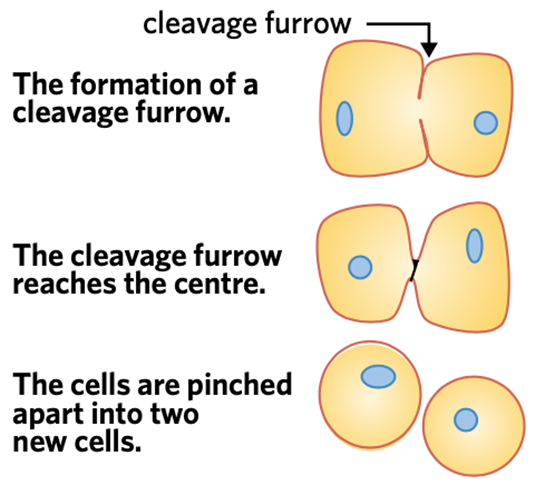
Cytokinesis in plant cells?
Plant cells have no cleavage furrow and so a cell plate forms in the middle of the original cell, meaning the cell wall begins being synthesized and a new cell walls are formed producing two new cells.
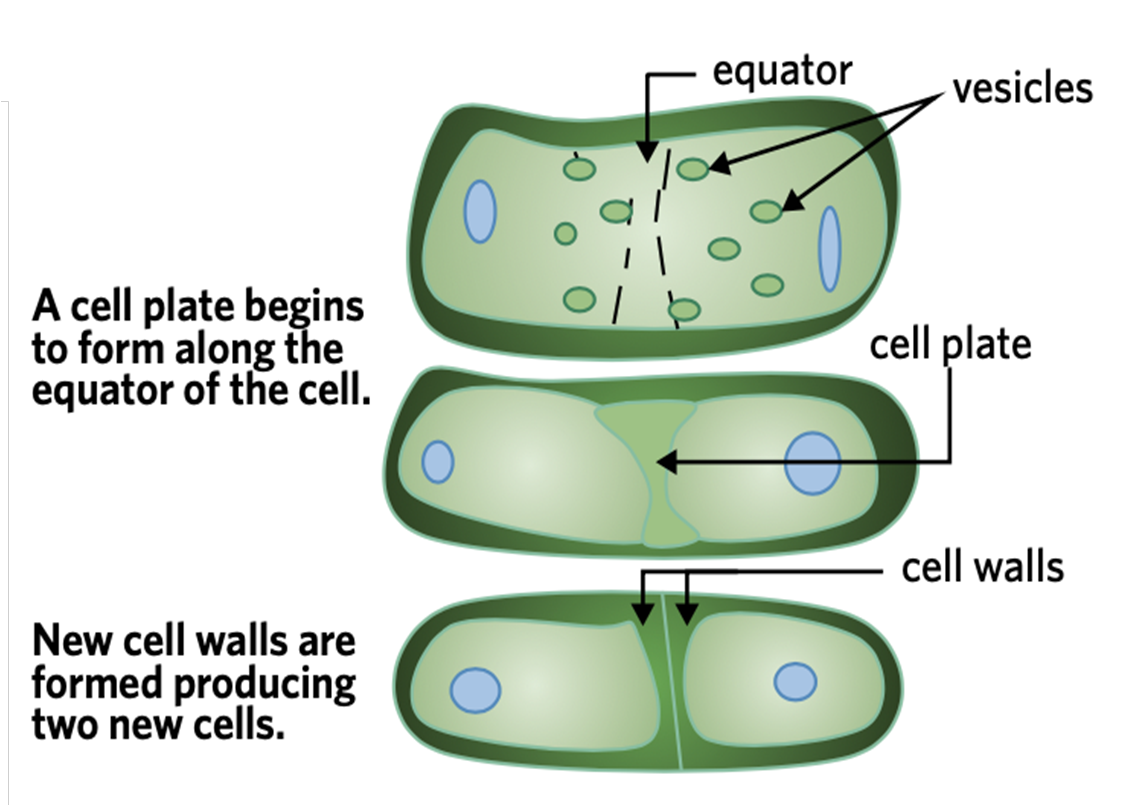
What are the 3 checkpoints where errors are detected in the eukaryotic cell cycle?
G1 checkpoint
G2 checkpoint
M Checkpoint
What happens in the errors are detected at the 3 checkpoints in the eukaryotic cell cycle?
The cells can pause for repairs but if the damage is not fixable then the cell undergoes apoptosis
What happens at the G1 checkpoint in eukaryotic cell cycle?
Cell checks it has grown to correct size, synthesized enough proteins and that DNA has not been damaged during mitosis
What happens at the G2 checkpoint in eukaryotic cell cycle?
Cell checks that DNA has been replicated properly in S phase
What happens at the M checkpoint in eukaryotic cell cycle?
cell checks the formation of the spindle fibres.
What occurs in Interphase?
The DNA is in its chromatin form (unwound) so the DNA is not visible under a light microscope.
What are the two types of genes that play a major role in regulating the cell cycle ?
Proto-oncogenes: Stimulate cell division
Tumor-suppressor genes: Inhibit cell divison
What does genetic control do?
maintains balance between the activity of these genes keep normal cells dividing at a normal rate
What do Proto-Oncogenes do?
Code for proteins that stimulate the cell to grow and divide.
What are Proto-oncogenes required for?
They are required for growth and development
What happens if there are mutations in Proto-Oncogenes?
Can cause them to become oncogenes leading to uncontrolled cell growth and cancer.
What are Tumor-Suppressor Genes?
Normal genes coding for proteins that slow down or stop cell division, repair DNA mistakes or promote apoptosis
What happens if Mutations occur in Tumor-suppressor genes?
Lead to uncontrolled cell division
What is Cancer?
A disease caused by uncontrolled replication of cells
What is a tumor?
a mass of abnormal cells.
What are the two types of tumors?
Benign
Malignant
What is Metastasis?
Migration of tumor cells from the primary tumor site to other parts of the body
What are the characteristics of Benign tumors?
Generally enclosed within a capsule and don’t spread throughout the body
Relatively slow growing
Not cancerous
What are the characteristics of Malignant tumors?
Cells of benign tumors mutate further
Spread throughout the body (metastasis)
Impair organ function
Are cancerous
What are characteristics in Tumors?
Self sufficiency
Antigrowth Deactivation
Blood supply formation
Tissue invasion and metastasis
What is it important to note with Tumor Characterisitics?
That tissue invasion and metastasis are unique to cancer cells
What is self sufficiency in tumors?
They can replicate without chemical growth signals by producing their own chemical signals or by permanently activating cell growth.
What is antigrowth deactivation in tumors?
tumour cells can disable mechanisms that can prevent cell replication.
What is increased survival in tumors?
Tumor cells are able to replicate immortality theoretically allowing them to divide forever but due to lack of nutrients provided by blood vessels tumour cells can still die.
What is blood supply formation in tumors?
Tumour cells can form new blood vessels when growing to maintain adequate nutrient and oxygen supply
What is tissue invasion and metastasis in cancerous/malignant tumors?
They can invade nearby layers of tissue and migrate to other parts of the body away from the primary tumour site typically via the bloodstream or lymphatic systems
When does Genetic Predisposition to Cancer occur?
Occurs when the DNA carries an allele that is likely to behave in certain ways under certain circumstance
Examples of genetic predisposition to cancer?
inherited in BRCA1 and 2 genes increases the risk of developing breast or ovarian cancer in females
What are Mutagens?
Agents that can cause or increase the frequency of mutations in DNA
What are Teratogens?
Agents which disrupt embryonic development leading to birth defects
What are examples of Teratogens?
Thalidomide
Alcohol
Drugs
Smoking
Some medications
What is Apoptosis also referred to as?
Programmed cell death
What is Apoptosis?
Death of cells that occur in a highly regulated sequence in response to specific signals received by the condemned cell
What is the purpose of Apoptosis?
The purpose is the remove;
Cells at the end of their natural life
Dysfunctional, damaged or diseased cells
Excessive cells (such as fetal development syndactyly)
What are the two types of apoptosis?
Mitochondrial (intrinsic) pathway
Death receptor (extrinsic) pathway
What do both pathways of apoptosis involve?
The activation of proteins called caspases
What are caspases?
Enzymes that break down proteins. Caspases are pro-apoptotic and intimate apoptosis
What is the purpose of the caspases?
to cleave intracellular proteins including cytoplasmic proteins like the cytoskeleton and nuclear proteins (DNA).
Are there many different types of caspases?
Yes, there are many different types involved in apoptosis
How are caspases activated?
in a caspase cascade
What is a caspase cascade?
Its a series of connected events that are triggered by an initial signal.
How does the caspase cascade occur?
The products of one stage activates the reactants of the next stage and so on, generally amplifying the signal.
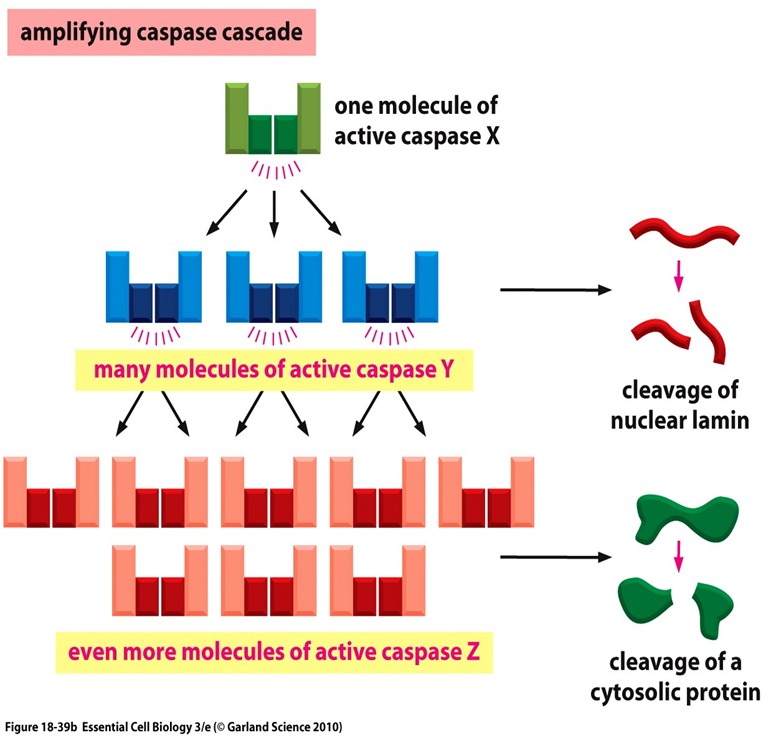
What is an Apoptosome?
Apoptosome is a large protein structure formed during apoptosis.
How does the apoptosome form?
It’s formation is triggered by the release of cytochrome c from the mitochondria in response to the intrinsic or extrinsic pathways.
What happens when the apoptosome is formed?
It can then activate caspases
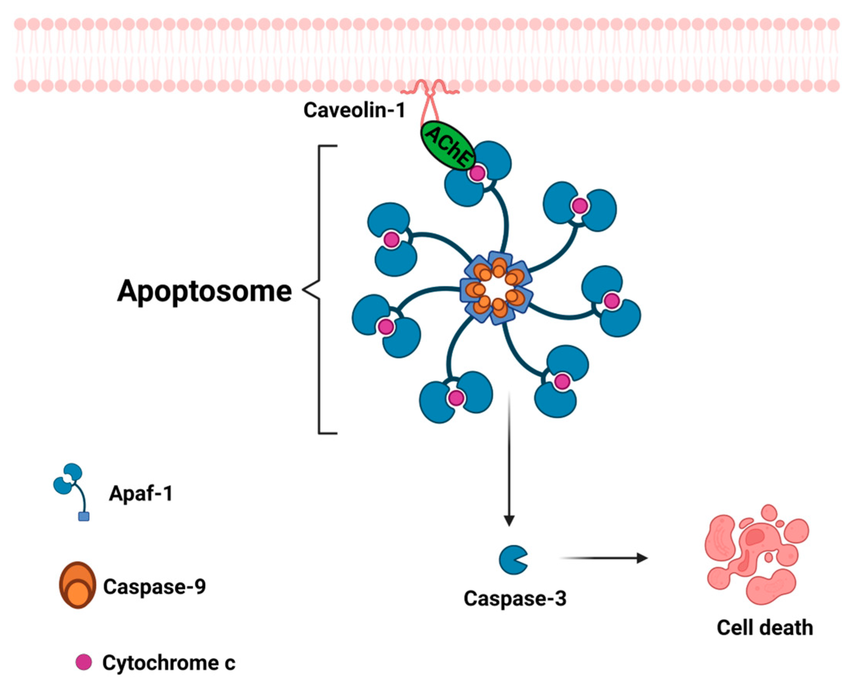
What is the mitochondrial intrinsic pathway
The mitochondrial (intrinsic) pathway is initiated when a death signal comes from inside the cell in response to irreparable mutations or DNA damage.
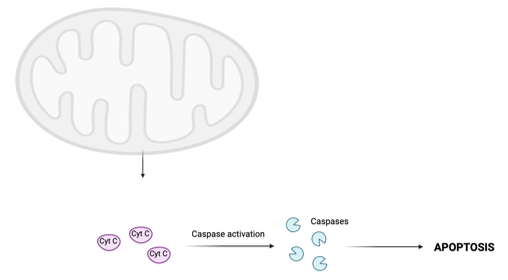
Steps to mitochondrial intrinsic pathway?
Mitochondria receives pro-apoptotic signal in response to cell damage and begins to break down releasing a protein called cytochrome c.
Cytochrome c activates caspases
Caspase activation triggers apoptosis
What is the Death receptor (extrinsic) pathway?
Initiated when a death signal comes from the outside of the cell
What are the steps to Death receptor (extrinsic) pathway?
Death signaling molecules bind to death receptors on the plasma membrane of a cell
This binding activates caspases
caspase cascade triggers apoptosis
What are the steps of apoptosis?
Caspases are activated and travel around the cell
Caspases digest organelles, DNA and cytoskeleton
Cell shrinks due to digestion and nucleus condenses
Plasma membrane blebs and detaches creating apoptotic bodies
Cell signals phagocytes to engulf and further digest apoptotic bodies
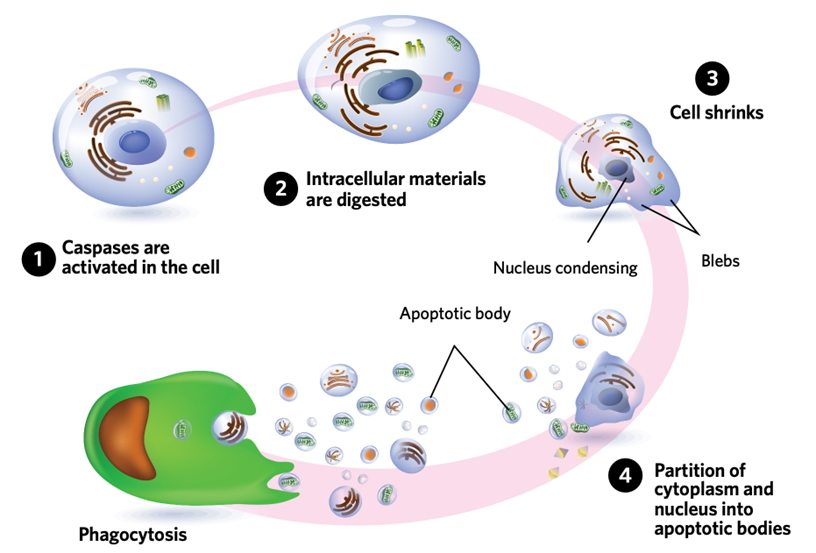
What is necrosis?
The premature death of a cell caused by disruption to the cell by injury, toxin or nutritional deprivation.
What happens to the cell in necrosis?
The cell loses functional control and there is destabilization of the plasma membrane.
What can happen to the cell in necrosis?
Leads to swelling of the cell and organelles due to increased pressure eventually causing cell to burst (lyse).
What happens when the cell bursts in necrosis?
the uncontrolled release of the cells contents causes inflammation, potentially damaging the surrounding tissue.